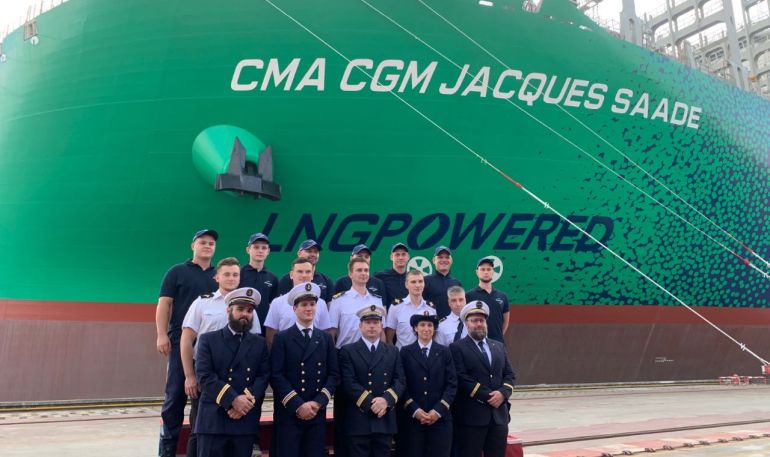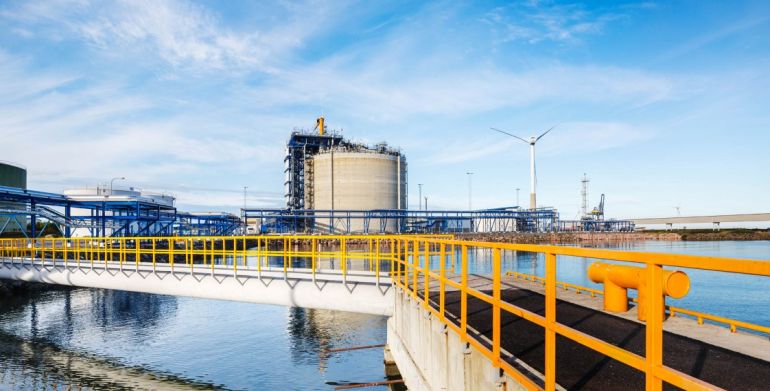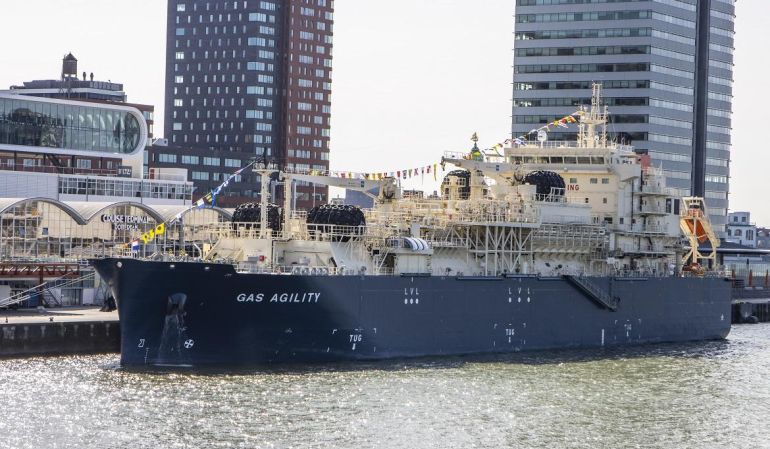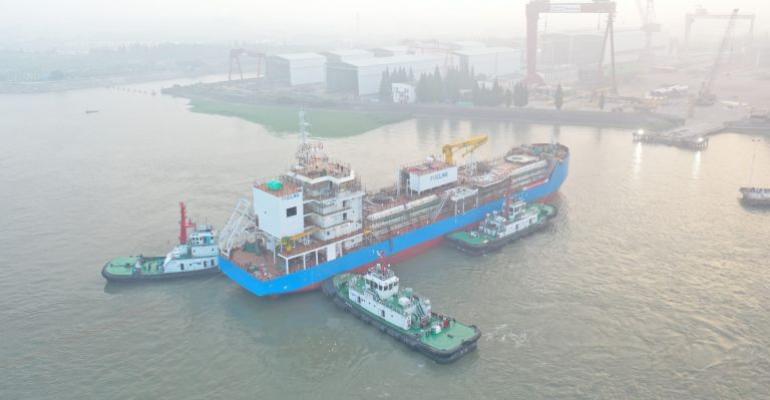Globally, LNG bunkering facilities are being established alongside a gradual rise in the number of LNG bunker tankers to support ship-to-ship fuel transfers, in addition to major players securing fuel supply deals and placing orders for LNG-powered newbuildings and
Perhaps the most significant new LNG-powered ships entering into operations are the series of nine 23,000-teu CMA CGM containerships, with the first vessel making a maiden call in Singapore on 12 October.
World’s largest LNG powered containership calls in Singapore

On a smaller scale, Taiwan’s dry bulk owner U-Ming in November ordered four LNG dual-fuel 190,000-dwt capesize newbuilds on the back of 10-year charters with mining giant Anglo American.
The fleet of four vessels, to be delivered through 2023, is expected to transport around 5m tonnes of iron ore a year from Anglo American’s operations in Brazil and South Africa, with both U-Ming and Anglo American committing to reduce greenhouse gas (GHG) emissions.
U-Ming orders LNG-fuelled capesizes for Anglo American 10-year charters
Australia’s mining giant BHP has also shown its commitment to reduce GHG emissions by awarding a LNG supply agreement to Shell for five LNG-powered newcastlemax bulkers for transporting iron ore between Western Australia and China from 2022. The bulkers are chartered by BHP for five years from Eastern Pacific Shipping.
BHP seals LNG supply contract with Shell for five newcastlemaxes
Back in January, Chinese firms Zhejiang Wuxing Logistics and Shanghai Zhixian Transportation Shipping have agreed to jointly invest in and construct four plus four LNG dual-fuel 26,000-dwt multipurpose heavy lift carriers. The first vessel, scheduled for delivery by end-2020, will be deployed for the transportation of LNG modules to Russia, Singapore and Malaysia via the Chinese port of Mentou in Zhejiang province.
Wuxing Logistics, Zhixian Transportation Shipping developing LNG-fuelled heavy-lift vessels
In October, China’s Guangzhou Shipyard clinched an order from Hafnia for two LNG-powered aframax LR2 tankers, for long term charter to French oil major Total upon delivery in 2023.
Hafnia orders LNG-powered tanker pair at Guangzhou Shipyard
Infrastructure developments look promising
Throughout 2020, various new and existing LNG bunkering facilities globally are being developed to further boost the viability of using LNG as a marine fuel.
In January, LNG solutions firm KC LNG and cryogenic equipment supplier Cryostar clinched a contract to build a LNG ship bunkering and truck fuelling facility in Belgium’s Antwerp port.
KC LNG and Cryostar clinch contract to build LNG bunkering facility in Antwerp
In March, Lithuania’s port of Klaipeda conducted its first LNG bunkering with the supply of the clean fuel to a cement carrier from the Malkos Bay Terminal. LNG bunker supplier Cryo Shipping said it will charter a LNG bunker tanker to promote Klaipeda as a key LNG bunker port in the Baltic and introduce ship-to-ship bunkering to the market.
Lithuania’s Klaipeda port embarks on LNG bunkering
In China, a Shenzhen international offshore LNG refueling centre project is being developed at Yantian port. The project aims to satisfy LNG fuel demands in China’s coastal area and attract more international LNG fuelled vessels to berth at Chinese ports. Upon the completion of the project, it is expected to achieve 230,000 tonnes of LNG refuelling volume annually.
Yantian develops first international offshore LNG refuelling project in China
Back in Europe, Finland’s state-owned gas firm Gasum opened a new LNG bunkering station at Sweden’s port of Stockholm premise in July. After a year of construction, the new bunkering station enables two truck-to-ship loading and unloading at the same time, saving time and promoting operational efficiency.
Gasum opens new LNG bunkering station in Stockholm
In November, Poland’s port of Szczecin made its first foray into LNG bunkering with also a truck-to-ship operation. In the same month, Spanish utility firm Endesa announced plans to invest $35.6m to develop a LNG bunkering supply chain at its port terminal in Los Barrios in the Bay of Algeciras.
Poland’s Szczecin port conducts first LNG bunkering
Spain’s Endesa to invest $35m to develop LNG bunkering at Algeciras
In the Americas, Cananda’s Cryopeak LNG Solutions Corp and Japan’s Sumitomo Corp penned a memorandum of understanding in September to jointly develop a LNG bunker fuels supply chain in Western Canada’s ports including Vancouver, Fraser River Port, Roberts Bank and Prince Rupert. Cryopeak is developing a proprietary design for a 4,000-cu m LNG bunkering barge to be used in an articulated tug and barge configuration (ATB), with plans to be in operation in 2023.
Cryopeak and Sumitomo to develop LNG bunkering for western Canada

Pavilion Energy and Gasum partner in global LNG bunker network
Singapore, the world’s largest bunkering port, is moving to entrench its position by scaling up its LNG bunkering capabilities. Chee Hong Tat, Singapore’s senior minister of state, ministry of transport and ministry of foreign affairs, said in October that the Maritime and Port Authority of Singapore (MPA) is ready to issue additional LNG bunker supplier licences to support the growing demand for LNG bunkers.
Singapore to seek more companies for LNG bunkering licenses
LNG bunker tankers making entry
Singapore launched its first LNG bunker tanker in June – a 7,500-cu m vessel operated by FueLNG, a joint venture between Keppel Offshore & Marine and Shell Eastern Petroleum. The bunker tanker was built at Keppel Nantong Shipyard in China.
Singapore’s first LNG bunkering tanker launched
The availability of LNG bunker tankers worldwide is seen as one of the key hurdles for the industry to overcome, as LNG bunker tankers are costly to build and stakeholders have been cautious to put in the investments.
But in addition to Singapore’s first bunker tanker, there have been positive developments on LNG bunker tankers in other countries as well.
At the start of this year, Public Gas Corporation of Greece (DEPA) and European Investment Bank (EIB) signed an agreement with financing of up to $22m to construct the first LNG bunkering vessel for use in Piraeus, Greece. With a capacity of 3,000-cu m of LNG, the bunker tanker is expected to be the first of its kind in Greece and the Eastern Mediterranean.
$20m financing deal signed to construct LNG bunker vessel for Greece
In August, Japan launched its first bunker tanker capable of delivering both LNG and very low sulphur fuel oil (VLSFO). The 4,100 tonnes vessel, named Ecobunker Tokyo Bay, has a LNG tank capacity of 2,500-cu m and a VLSFO tanker capacity of 1,500-cu m.
Japan launches LNG-VLSFO bunker tanker
The following month, Japan launched its first pure LNG bunker tanker, the Kaguya, which will be operated by LNG Marine Fuel Japan Corp and be based at JERA’s Kawagoe Thermal Power Station to deliver LNG to ships in the Chubu region.
The bunker tanker Kaguya proceeded to conduct Japan’s first ship-to-ship LNG bunkering for a NYK pure car and truck carrier (PCTC) in October.
Japan conducts first ship-to-ship LNG bunkering

World’s largest LNG bunker vessel named
Toward the end of the year, oil major Shell said it aims to double its LNG bunkering fleet by 2025 in view of the expected increase in the use of the clean gas for ships. Shell’s executive vice-president Steve Hill was reported saying that LNG is readily available “in all major ports” and a widespread use as a marine fuel only requires “those last mile investments”. Shell currently has six LNG bunker tankers in operation or about to start service.
Shell aims to double LNG bunker tanker fleet by 2025
At the Seatrade Maritime Middle East Virtual panel discussion held on 15 December, LNG and LPG have been singled out as the available fuel options right now for shipping to move towards its decarbonisation goal.
DNV GL – Maritime’s business development manager Christos Chryssakis said LNG and LPG are the two marine fuels that can make a “real impact today”, while svp of ship management for Adnoc Logistics & Services Capt Mohamed Al Ali said LNG is the right fuel type for its VLCCs and aframaxes.
Steve Esau, general manager of SEA-LNG, concurred that LNG offers immediate greenhouse gas reductions and paves the way for further long term decarbonisation through the use of zero emissions bio-LNG and synthetic LNG.
Read more: Using LNG and LPG as fuel – practical solutions to shipping’s energy transition
Copyright © 2024. All rights reserved. Seatrade, a trading name of Informa Markets (UK) Limited.
Add Seatrade Maritime News to your Google News feed.  |

